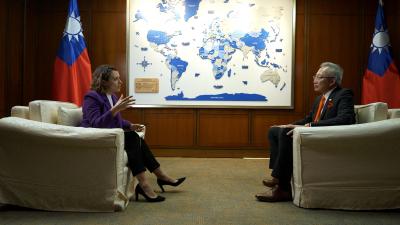The future of clean energy lies in deserts around the world, where sunlight is abundant and opportunity costs are relatively low, said a key presenter at an international forum in Taipei yesterday on ending global warming.
Gerhard Knies, coordinator of the Trans-Mediterranean Renewable Energy Cooperation, a network of some 50 experts in renewable energy and sustainability, told the forum that such technologies may create not only revenue, but employment opportunities as well.
During the two-day forum, titled "Asia's Future in a Hotter World," locals and congeressional representatives from Japan, Australia, India, Hong Kong, Germany, and the Philippines gave presentations and exchanged views on environmental and technology issues.
"The amount of energy available for harvest in deserts around the world is 700 times the needed amount to support a 10 billion global population, which is the projected population in 2050," Knies said.
Clean energy development is a pressing issue globally since coal-burning energy imposes environmental damage that is suffered by the entire human race. Fossil fuel is becoming increasingly scarce and expensive, particularly in Asian where such resources are short to begin with, he said.
"The world faces a `10 over 3' crisis, meaning, in 2050 the world population is predicted to balloon to 10 billion from the current 6 billion. However, fossil fuel burning will at the same time compromise the world's capacity to support only 3 billion people," he said.
A switch to clean energy solves the problem in two ways, he said.
"First it halts the process of world capacity decrease, secondly, it is sustainable and abundant," he told the forum.
Among the array of available technologies, Knies recommended solar energy since it is "the only clean energy that fits the bill as being sufficient for the world population, cheap to mass produce, has rare intermittences and can be readily deployed on a mass scale to meet emerging demands."
To drive the expensive solar power plant costs down, Knies said building them in deserts was best.
"The idea is simple -- if you put a solar panel in your room, you would not get a lot of sunlight; if you wire it to a HVDC [high voltage direct current] power line and put your panel on your roof, you would need to pay extra for the wire, but your increased output would out-value your investment," he said. "The seemingly low cost of dirty energy is bound to detriment the world later; and the cost of [renewable energy] is lower than risking having no energy at all."
"The cost can be further driven down by on-site heat storage in the power plants," he said.
And the switch to solar energy presents a massive business opportunity. Based on an estimated global population of 10 billion for 2050, there needs to be solar panels capable of generating 400 million watts of energy each day to meet the demand of supplying 50 percent of the world power needs with solar energy, Knies said.
"The rapid increase rate cannot be matched by dirty energy sources like, say, nuclear plants -- it would be near impossible to build them fast enough to increase the world's energy capacity by 400 million watts of energy per day," he said, adding that dirty energy sources should be gradually phased out.

“China is preparing to invade Taiwan,” Deputy Minister of Foreign Affairs Francois Wu (吳志中) said in an exclusive interview with British media channel Sky News for a special report titled, “Is Taiwan ready for a Chinese invasion?” the Ministry of Foreign Affairs said today in a statement. The 25-minute-long special report by Helen Ann-Smith released yesterday saw Sky News travel to Penghu, Taoyuan and Taipei to discuss the possibility of a Chinese invasion and how Taiwan is preparing for an attack. The film observed emergency response drills, interviewed baseball fans at the Taipei Dome on their views of US President

The Central Weather Administration (CWA) today issued a "tsunami watch" alert after a magnitude 8.7 earthquake struck off the Kamchatka Peninsula in northeastern Russia earlier in the morning. The quake struck off the east coast of the Kamchatka Peninsula at 7:25am (Taiwan time) at a depth of about 19km, the CWA said, citing figures from the Pacific Tsunami Warning Center. The CWA's Seismological Center said preliminary assessments indicate that a tsunami could reach Taiwan's coastal areas by 1:18pm today. The CWA urged residents along the coast to stay alert and take necessary precautions as waves as high as 1m could hit the southeastern

The National Museum of Taiwan Literature is next month to hold an exhibition in Osaka, Japan, showcasing the rich and unique history of Taiwanese folklore and literature. The exhibition, which is to run from Aug. 10 to Aug. 20 at the city’s Central Public Hall, is part of the “We Taiwan” at Expo 2025 series, highlighting Taiwan’s cultural ties with the international community, National Museum of Taiwan Literature director Chen Ying-fang (陳瑩芳) said. Folklore and literature, among Taiwan’s richest cultural heritages, naturally deserve a central place in the global dialogue, Chen said. Taiwan’s folklore would be immediately apparent at the entrance of the

ECONOMIC BENEFITS: The imports from Belize would replace those from Honduras, whose shrimp exports have dropped 67 percent since cutting ties in 2023 Maintaining ties with Taiwan has economic benefits, Ministry of Foreign Affairs officials said yesterday, citing the approval of frozen whiteleg shrimp imports from Belize by the Food and Drug Administration (FDA) as an example. The FDA on Wednesday approved the tariff-free imports from Belize after the whiteleg shrimp passed the Systematic Inspection of Imported Food, which would continue to boost mutual trade, the ministry said. Taiwan’s annual consumption of whiteleg shrimps stands at 30,000 tonnes, far exceeding domestic production, the ministry said. Taiwan used to fill the gap by importing shrimps from Honduras, but purchases slumped after Tegucigalpa severed diplomatic ties with Taiwan